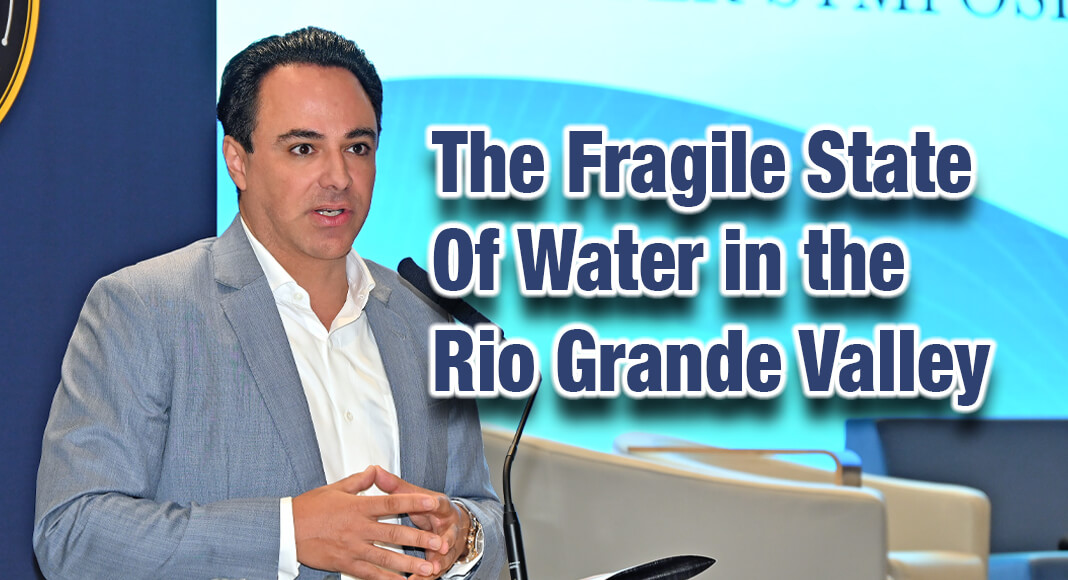
Texas Border Business
By Roberto Hugo González
PHARR, Texas – Water—this seemingly abundant yet profoundly precious resource—is increasingly becoming a dire concern in the Rio Grande Valley. For years, many have taken the availability of water for granted, turning on taps and wasting it without a second thought. The reality, however, is starkly different. As droughts persist, international agreements falter, and climate change brings unpredictable weather patterns, the very lifeblood of this region is at risk. Texas State Representative Terry Canales stressed the gravity of the situation during a recent symposium sponsored by the city of Pharr on August 20, 2024.
“Many of us waste [water] multiple times a day. Every time we turn on the tap, we use water indiscriminately, as if it could never run out,” Canales pointed out, highlighting a problem that has plagued the Valley for years: complacency in the face of a growing crisis.
Over the past two years, the Rio Grande Valley has experienced a severe drought, compounding an already critical water shortage. The situation is exacerbated by Mexico’s alleged violation of the 1944 water treaty, which obligates Mexico to deliver water to the United States. The lack of compliance with this treaty has significantly reduced the water available in the Falcon and Amistad reservoirs, crucial sources for the Valley’s water supply.
Canales did not mince words when addressing this issue: “With the drought we’ve had in the last two years, the impact of Mexico’s violation of the 1944 treaty, and the fact that we haven’t had a cyclone to bring the necessary rain to the Falcon and Amistad reservoir regions, it indicates that we are at the end—yes, the end—of our abuse of this precious resource.”
The Representative’s words are a stark reminder that the situation is reaching a tipping point. Without immediate and coordinated action, the Valley could face a future where water scarcity becomes a harsh reality rather than a distant concern.
A Call for Action
Rep. Canales recounted his growing concern upon realizing the depth of the water crisis. “When Eddie Lucio, III retired in 2021, during the session before last, I asked my staff who was in charge and who was taking the reins on water, and nobody was. And so, I ordered my staff to start digging down and learning as much as possible. And the more I learned, the more scared I became and the more concerned I became.”
This concern has driven Canales to call for a unified approach to addressing the water crisis. “We have to come together cohesively from farmers, ranchers, and municipalities,” he emphasized, pointing out that the region’s fragmented response has only worsened the problem.
Canales praised the efforts of various entities, such as the city of McAllen’s initiative to blend brackish water to increase its water supply. Still, he also acknowledged that these efforts are insufficient on their own. “It’s not enough,” he said. “Right now, we are talking about the Mexican water treaty. That’s only one-third of the two-thirds that we need. We need to do more.”
The Need for Regional Unity
According to Canales, one of the most significant obstacles to resolving the water crisis is the need for more unity across the Rio Grande Valley. He criticized the region’s divisions, with different cities and irrigation districts pursuing their own, often conflicting, agendas. “We are a region; if we don’t come together, we will fall together,” he warned.
Canales recounted a chilling realization that many in the Valley might face sooner than expected: “This morning, I looked at my tap and turned it on… I’ve received two notices from my local supplier in the last, I don’t know, 12 years saying, you’ve got 30 days of water left.”
The dependency on external factors—whether Mexico’s compliance with the 1944 treaty or the occurrence of cyclones—places the Valley in a precarious position. “We depend on Mexico, another foreign country, and rely on extreme weather events in the Rio Grande Valley for our water,” Canales stated, emphasizing the urgent need for proactive measures rather than reactive hopes.
Canales is not without hope, but his hope is grounded in action. He called for a regional summit where leaders across the Valley could devise a comprehensive and cohesive water strategy. “Let’s get one meeting together where people who care, people who have authority, and people who know we have a problem can come together and help us start forming what I would call a cohesive group of focused minds for the region,” he proposed.
He also urged local governments to prioritize water in their planning, warning of the dire consequences of inaction. “A city that’s not issuing construction permits is a city of decline… if cities decline in the Rio Grande Valley because we lack water, that should be a wake-up call.”
The symposium in Pharr, marked by Canales’ impassioned plea, was a clarion call for the Rio Grande Valley. The water crisis is not a distant threat but a pressing reality that demands immediate action. As Canales aptly put it, “Water is life. This room is full of life.”
The Valley’s future depends on its ability to come together, plan effectively, and take decisive action now. As Rep. Canales concluded, “If we don’t do it today, they won’t have water tomorrow.” Every Valley resident, leader, and stakeholder is responsible for ensuring a sustainable water future. The time to act is now.
See Related Stories:
















